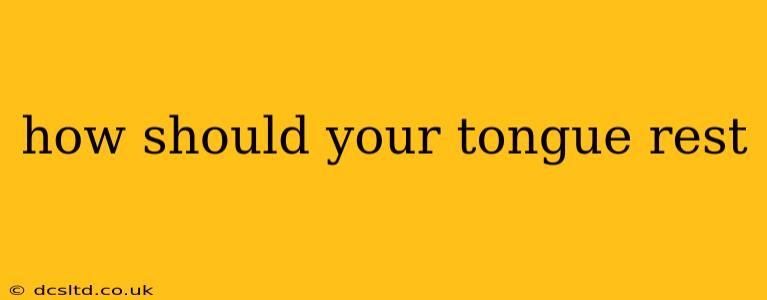Many people don't think about their tongue's resting position, but it plays a crucial role in oral health, facial structure, and even breathing. Proper tongue posture, often referred to as resting the tongue on the roof of the mouth, is key to optimal health and well-being. This article will delve into the specifics of how your tongue should rest, the benefits of correct posture, and what happens when it's misplaced.
What is the Correct Tongue Resting Position?
The ideal resting position for your tongue is gently resting against the roof of your mouth, specifically behind your upper teeth, touching the gum line. This isn't a forceful press; it's a soft, natural contact. Imagine you're lightly suctioning your tongue to the roof of your mouth. This position allows for proper airflow and optimal jaw alignment.
What are the Benefits of Proper Tongue Posture?
Correct tongue placement offers numerous advantages:
-
Improved Breathing: Proper tongue posture facilitates nasal breathing, which filters and humidifies air before it enters the lungs. This is crucial for better sleep quality, reduced snoring, and overall respiratory health.
-
Enhanced Jaw Alignment: The tongue acts as a natural splint for the jaw, helping to maintain proper alignment. This can alleviate temporomandibular joint (TMJ) disorders and improve facial structure.
-
Better Oral Health: Keeping your tongue on the roof of your mouth helps prevent crowding of teeth, improves swallowing, and stimulates saliva production, which protects against cavities and gum disease. Furthermore, it helps maintain a healthier oral microbiome by reducing the chances of bacteria buildup.
-
Reduced Snoring and Sleep Apnea: By keeping your airway open and facilitating nasal breathing, correct tongue posture can reduce snoring and even mitigate some symptoms of sleep apnea.
-
Improved Facial Structure: This is long-term, but maintaining proper tongue posture over time can contribute to a more balanced and aesthetically pleasing facial structure.
What Happens if My Tongue Doesn't Rest Correctly?
Incorrect tongue posture, such as resting your tongue between your teeth or low in your mouth, can lead to several problems:
-
Mouth Breathing: This can lead to dry mouth, increased risk of infection, and poor sleep quality.
-
Misaligned Teeth and Jaw: Over time, incorrect tongue posture can contribute to crooked teeth, overbites, underbites, and TMJ disorders.
-
Sleep Disordered Breathing: It can worsen snoring and sleep apnea, affecting sleep quality and overall health.
-
Changes in Facial Structure: Long-term incorrect tongue placement can potentially lead to changes in facial structure, including a collapsed midface or gummy smile.
How Can I Correct My Tongue Resting Position?
Many people need to consciously retrain their tongues. Here are some tips:
-
Become Aware: Pay attention to your tongue's position throughout the day. Notice when it drops.
-
Gentle Reminders: Throughout the day, gently guide your tongue back to the roof of your mouth.
-
Tongue Exercises: Simple exercises, such as pressing your tongue against the roof of your mouth for several seconds, can help strengthen the muscles and reinforce correct posture.
-
Mewing: This technique involves consciously maintaining proper tongue posture, often combined with good posture. Note: Consult with a professional to ensure you are performing this technique correctly.
-
Consult a Professional: If you're struggling to correct your tongue posture or suspect related problems, consulting an orthodontist, dentist, or ENT specialist is advisable.
How Does Tongue Posture Relate to My Breathing?
Proper tongue posture directly impacts breathing by ensuring your airway remains open and allowing for efficient nasal breathing. When your tongue rests correctly, it naturally helps to keep your airway open, promoting nasal breathing, which is more beneficial than mouth breathing.
Are There Specific Exercises to Improve Tongue Posture?
Yes, various exercises can help strengthen the muscles responsible for maintaining proper tongue posture. These often involve consciously pressing your tongue against the roof of your mouth for extended periods or performing specific tongue movements.
Can Tongue Posture Affect My Facial Structure?
Yes, long-term tongue posture can influence facial structure. Correct posture can help maintain the proper development and alignment of facial bones, while incorrect posture may lead to changes such as a receded jawline or altered facial profile. This effect is most significant during childhood and adolescence.
By understanding the importance of proper tongue posture and implementing strategies to correct it, you can improve your oral health, sleep quality, breathing, and potentially even your facial aesthetics. Remember to consult with healthcare professionals if you have concerns about your tongue posture or related issues.
